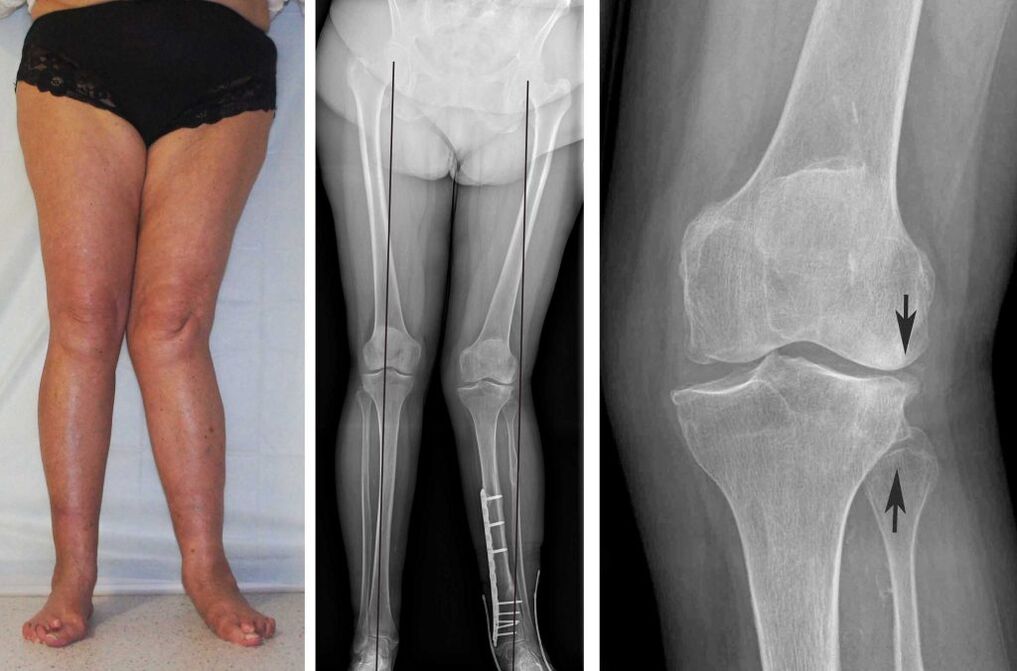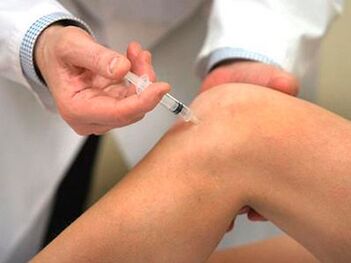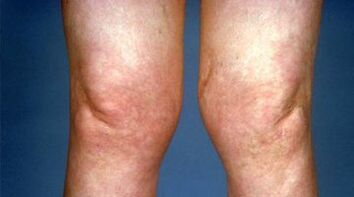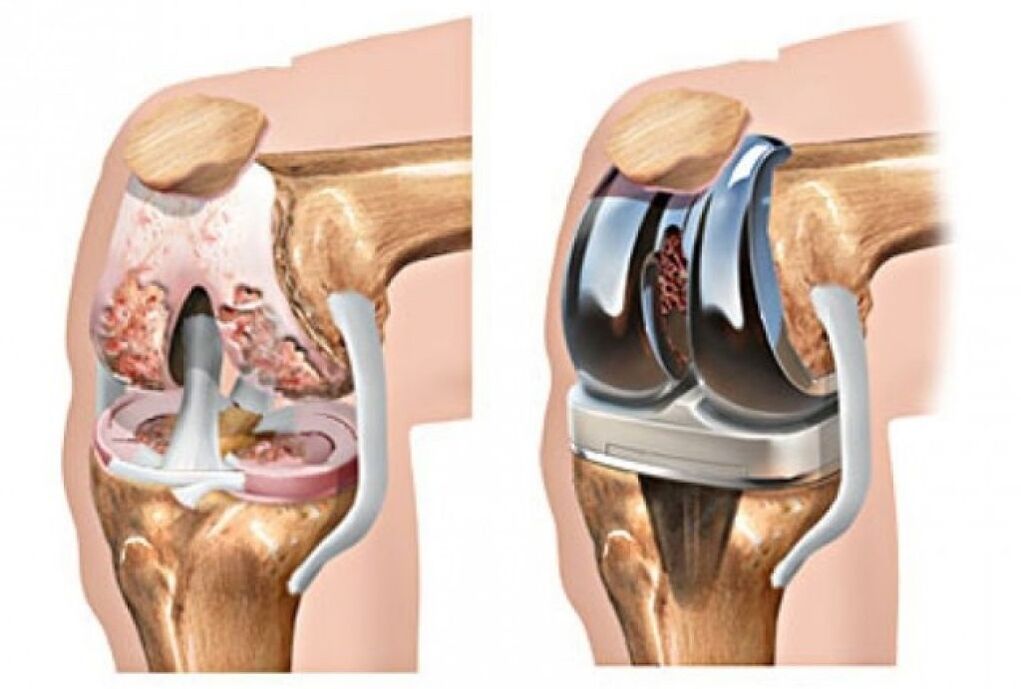Knee osteoarthritis is progressive. As the disease develops, cartilage first suffers, then bone elements participate in the destructive process. High physical activity, physical inactivity, metabolic disorders lead to the causes of problems.
With the development of the disease, there is a risk of ankylosis, which is accompanied by a decrease in the motor activity of the joint.
Characteristics of the disease

Arthrosis of the knee joint is accompanied by deformation and destruction of the cartilage. The pathology is characterized by a chronic degenerative nature and causes pain of varying degrees of intensity.
It provokes a complete loss of motor activity and loss of functionality. According to ICD-10, the disease is coded as follows: M17. Gonarthrosis (arthrosis of the knee joint).
Pathologies are more sensitive to women than men. At the same time, the risk of arthrosis is much higher in people with varicose veins and overweight. This is why the disease is more common in obese women over 40 years of age. The elderly are also affected. In young people, arthrosis develops as a result of injuries that occur during physical work or sports activities.
Arthrosis must be distinguished from arthritis, which is an inflammatory disease caused by disorders in the immune system. Infectious diseases also lead to the development of arthritis.
In the photo, the clinical picture of arthrosis

stages
Osteoarthritis of the knee joint has 2 main types - primary and secondary. In the first case, the disease appears in childhood and is caused by a violation of the development of the joint surfaces or ligaments.
In this situation, the joint faces increased loads, which leads to degenerative changes. The secondary form of arthrosis is associated with injuries and other diseases.
Pathology can be unilateral or bilateral. In the first case, the cause of the disease is most often injuries. The bilateral form of the pathology is usually the result of obesity.
There are several stages in the development of arthrosis of the knee joint. The sooner a disease is detected, the easier it is to treat it.
The main stages of the disease include the following:
- 1 degree- at this stage, people rarely go to the doctor. They feel a slight discomfort in the right or left knee, which appears after a long walk. The pain syndrome appears only after increased physical exertion or strong bending and extension of the knee. During radiography, it is possible to see a slight narrowing of the joint space and the appearance of bony processes in the structure of the joints. Pathology is discovered accidentally during other examinations. At this stage, conservative therapy is sufficient.
- 2 degrees- characterized by more visible symptoms of the disease, which are difficult to ignore. Pain in the knee is felt constantly. It is especially intense in the morning and evening. Even in a calm state, anxiety does not disappear. A person's gait slows down, motor activity is disturbed, knee movements are accompanied by a creak. There is a risk of complications associated with the insertion of a piece of bone or cartilage into the joint cavity. This provokes an increase in pain and loss of motor activity. When palpating the knee, there is a risk of severe pain and visible deformation of the joint. Inflammatory processes often develop. In such a situation, the knee swells. When performing an x-ray, you can see a strong narrowing of the joint space, the presence of osteophytes, the curvature of the bones. In such a situation, the patient needs complex treatment. In some cases, it is not possible to do without surgery.
- 3 degrees- represents a neglected form of pathology. At this stage, a person receives a permanent disability. The patient has constant knee pain, impaired motor activity. With every movement, the knee creaks loudly. The connection is characterized by a pronounced deformation, increases in size due to fluid accumulation and almost completely loses mobility. When performing radiography, it is possible to see the destruction of the ligamentous apparatus and meniscus, the erosion of the cartilage and an increase in the size of the connective tissue. Partial fusion of the joints may also be observed. To solve the problem, the affected joint is changed to an artificial one.
In most cases, patients go to the doctor in the second stage of arthrosis. This is typical for older people who are accustomed to age-related changes.
Causes of osteoarthritis of the knee joint

The main cause of osteoarthritis is knee injury. The damage may be due to exercise, arthritis or other factors.
The main causes of osteoarthritis of the knee include the following:
- Inflammation of the knee - provoking factors can be arthritis, bursitis and other factors.
- Damage to the meniscus - in the absence of treatment of such a pathology, arthrosis often develops.
- Osteochondropathy of the knee.
- Physical factors - hard sports, excess weight, etc.
- Bone fractures, post-traumatic syndrome.
- Operations for meniscus lesions, arthroscopy, prolonged blockades using hormones.
- Pathologies that change the load on the knee. These include flat feet, back injuries, arthrosis. Hip dysplasia is also included in this category.
Symptoms and signs
The main manifestations of the disease include the following:
- Pain - most often there is a mechanical discomfort, which is relieved by sedatives. It can be dull, painful, sharp.
- Chew while moving.
- Impaired joint mobility.
- Decreased motor activity.
- Weakness of the muscles of the limbs.
- An increase in local temperature in the knee area.
- Gait disorder, which is accompanied by lameness of the legs.
- Violation of stability.
- Knee lock.
Diagnosing

Before starting the treatment of gonarthrosis, it is necessary to undergo a complete examination.
If you suspect gonarthrosis, you should contact an orthopedic traumatologist. The specialist examines and interviews the patient, assessing the condition of the joint and the range of motion in it.
To identify the pathology, perform such studies:
- Magnetic resonance imaging. With the help of the procedure, it is possible to study the affected area by taking a three-dimensional image. Manipulation shows blood vessels and nerve fibers.
- Radiography. The procedure allows you to identify cracks, depressions, bone processes.
What is dangerous arthrosis of the knee
The consequences of arthrosis include joint inflammation, atrophic changes in muscle tissue and ligaments, and gait disorders. There is also a risk of deformity of the lower limbs.
In severe situations, the disease causes complete degeneration of cartilage and deformation of bone structures. As a result, the mobility of the limbs decreases and the person becomes disabled.

Prevention and prognosis
To avoid the appearance of knee arthrosis, you should adhere to the following recommendations:
- eat properly - the menu should contain a lot of vitamins, minerals, proteins;
- give up bad habits;
- weight normalization;
- go for sports, walking or exercise bikes, perform medical complexes;
- avoid injuries, protect your legs with knee pads.
The pathology lends itself well to therapy, as the thinning of the cartilage tissue is observed only in the third stage. The prognosis is quite favorable.
If therapy is not started on time, there is a risk of disability. Usually the group is assigned with the third degree of gonarthrosis. As for military service, they are excluded from it with the development of a deforming form of the disease.
Osteoarthritis of the knee joint is a serious pathology that leads to negative health consequences. To cope with the problem, you should consult a doctor at the right time. The specialist will carry out the necessary studies and choose the appropriate therapy.
























